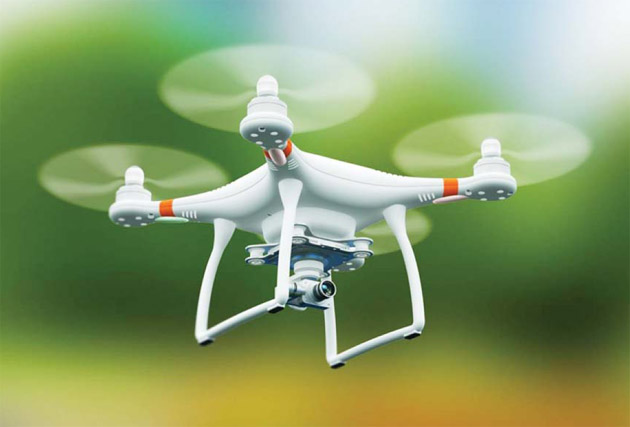Dr. Parshotam S Manhas
The term “drone” sometimes referred to as “Unmanned Aerial Vehicles” (UAVs) can carry out umpteenth tasks, ranging from military operations to package delivery. Drones have become almost ubiquitous as they are being extensively used across sectors for quick imagery and can reach places where humans cannot reach.
The widespread evolution of drones have made them more affordable and accessible but it cannot be ruled out that some nations have deployed them for otherwise malicious reasons like dropping IEDs, smuggling arms, ammunition, and drugs across borders. Drones can be a threat if not in the right hands and not used with due caution. In recent times, there have been many instances where drones have breached security and intruded into other territories. Such intrusion of drones underlines the exigent need for the armed forces to build capabilities to deter, detect and neutralize such aerial threats in the future and led to the development of anti-drone technology. Anti-drone systems are used to track and intercept unwanted drones and unmanned aerial vehicles (UAVs). Nowadays, there are a plethora of signal jammers, radio spoofers, drone interceptors, and compressed air guns that are designed to knock drones off the sky.
DRDO has developed anti-drone technology to disable or shoot down hostile drones. Its anti-drone system has a range of two to three kilometres with radar capability to pick up the drone and then use frequencies to jam the unmanned aerial vehicle.
Anti-drone technology is a sensitive subject that has long been mired in controversy among the drone pilot community, law enforcement, and the general public. Recent incidents involving the malicious use of drones have emphasized that anti-drone technology need to be a part of the arsenal of local law enforcers and other regulatory bodies.
The technology depends on a variety of techniques for detecting or intercepting drones. Most drones are spotted using techniques like Radio Frequency (RF) detection, Electro-Optical and Infrared and are then destroyed with techniques like RF Jamming, GNSS Jamming, Spoofing, Laser, nets, projectile, or Combined Interdiction Elements.
Today, there are many players in the market who are providing techniques to counter drones and some of the top counter-drone technologies are listed below.
Sky Fence: It a is fully programmable and automated electronic countermeasures system developed by UK firms Drone Defence and Eclipse Digital Solutions that can jam the signal that a drone uses to communicate with its pilot and prevents drones from flying into or close to a protected site by disrupting its command and navigation radio transmissions.
Drone Gun: It is a portable anti-drone technology developed by Australian firm DroneShield to jam and cut off signals between the drone pilots and its remote controller. It is a rifle-shaped device that uses radiofrequency jamming and GPS jamming to counter drones. This can either initiate the drone’s return-to-home function or force it to land gently to the ground. Keeping the drone intact is the goal of the DroneGun, as it aids in investigation and in locating the responsible drone pilot. The DroneGun is compact and can be operated by a single person. It can take down rogue drones up to a range of 1 km in a wide range of environmental conditions.
DroneCatcher is a net gun-armed multi-copter designed by Delft Dynamics. The system safely eliminates illegal drones from the air. The DroneCatcher shoots a net at the rogue drones in restricted airspace areas over places like airports and military installations to knock them out easily. It is highly effective against Multi-Rotor type drone which once tangled in the net drop-off of the sky easily.
SkyWall 100 developed by a team of UK-based engineers shoots out a net that can wrap around a suspicious drone and its propellers, eventually bringing it down. A ‘skywall 100’ is the ground version of the ‘drone catcher’ and it works by bringing down a UAV using a parachute that is hurled through a net from 100 meters distance and keeps the drone intact for further investigation.
SkyDroner detects, distract and disable drone from flying into a restricted zone. The system consists of multiple sensors to monitor the activity of a drone within a 1km range, identifies types of drones, and provides real-time tracking of flight paths by pinpointing the location of drones and their operators. After detection, the system can distract a drone by taking over the command and control frequencies and then disables communication links to the drones. During an emergency, it is capable of immobilizing the drone to prevent it from further intrusion.
ATHENA (short for Advanced Test High Energy Asset), developed by defense giant Lockheed Martin, is a high-energy laser system that can completely destroy the rogue drone in the air. The ATHENA is transportable and enables the Air Force to position it anywhere they need to defend bases and high-value assets. According to the developer of ATHENA, the technology can be handy in the near future for protecting soldiers against drone swarm attacks, even a large number of rockets and mortars.
Trending Now
E-Paper


